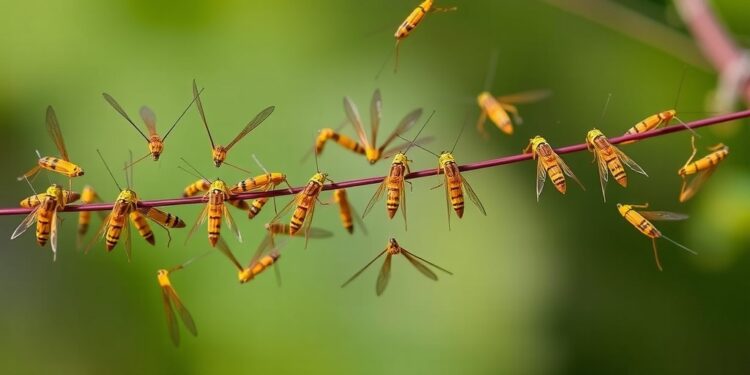New research published in the prestigious journal Science is altering long-held notions about the behavioral dynamics of locusts, particularly regarding their collective movement during swarming events. This study, led by a team of researchers that includes Greg Sword, Ph.D., a renowned entomologist and Regents Professor at Texas A&M University, challenges the traditional paradigm that locusts engage in synchronized, collective motion. Instead, it presents a groundbreaking perspective that locusts exhibit a form of uncoordinated, follow-the-leader behavior. This paradigm shift in understanding how swarms operate could have profound implications for developing strategies to manage and mitigate the impact of locust swarms, which are known to devastate agricultural lands across the globe.
The research reveals that the mechanics of locust swarming are dictated by a complex interplay between environmental factors and individual locust behaviors. Unlike the previous models that posited a uniform directional movement initiated by a few leader locusts, the new findings suggest that locusts are primarily influenced by their proximity to nearby individuals within the swarm. Essentially, individual locusts constantly adjust their movement based on the actions of their nearest neighbors, leading to collective patterns that can appear organized but are actually the result of decentralized individual responses.
As environmental factors such as terrain, vegetation availability, and overall locust density come into play, locusts at the head of the swarm may dictate the broad direction of travel. However, the swarm’s overall movement is largely determined by the interactions among individual locusts, each reacting in real time to those around them. This methodology of movement could illuminate why locust swarms are able to change direction rapidly in response to sudden alterations in their environment, such as obstacles encountered or food sources becoming available. The implications of this research extend beyond theoretical development; they open new avenues for enhancing locust control measures that could potentially save millions of dollars in agricultural damages.
A particularly fascinating aspect of this study is its focus on the behavioral plasticity exhibited by desert locusts during their life cycle. The phenomenon of locust phase polyphenism, where solitary locusts shift to a highly social swarm behavior as their populations increase, highlights their remarkable adaptability. This transformation is not only biological but also reflects significant changes in their social interactions and environmental responses. Upon reaching certain population densities, solitary locusts reconfigure their behavior, leading to the formation of swarms that can migrate over vast distances, causing catastrophic losses in crops and contributing to food insecurity across regions.
Desert locusts are equipped with a unique ability to sense the density of their peers, which triggers their transition from solitary to swarm behavior. This adaptive strategy enables them to react swiftly to environmental cues and predation, ensuring their survival amid fluctuating conditions. The research further posits that understanding the collective motion of these locusts through a decentralized model could facilitate the development of predictive tools for swarming movements. By knowing where swarms might head next, agricultural interventions could be better timed and targeted, thus reducing the potential for severe agricultural disruptions.
One major takeaway from this extensive research is the potential for enhanced monitoring systems informed by the new behavioral insights. By leveraging the understanding that locusts depend on their immediate neighbors for movement decisions, researchers might explore technologies such as drones or remote sensing tools to track swarm movements in real time. These technological integrations could lead to innovative locust management strategies that employ early detection and intervention tactics, preventing swarms from reaching agricultural areas.
Furthermore, this research may have implications for studying other swarming organisms, offering clues into the collective behavior of different species and contributing to our broader understanding of evolutionary biology and animal behavior. The inquiry into locust swarming mechanisms could serve as a model for elucidating similar collective behavior observed in other species, whether they be insects or larger terrestrial animals.
Significantly, the research transcends academic boundaries and combines expertise from diverse fields, including behavioral ecology and advanced simulations of animal behavior. Greg Sword emphasizes the importance of interdisciplinary collaboration in achieving breakthroughs in understanding complex biological phenomena. As researchers from various institutes in Europe joined forces with teams at Texas A&M University, the findings underscore the value of diverse methodologies and perspectives in addressing global challenges related to pest control and food security.
Overall, this pioneering research elevates our knowledge of locust behaviors, rendering complexities into relay points for further investigations. The implications of these findings could resonate within agricultural communities globally as they actively seek more effective means of pest management while anticipating the behaviors of these voracious insects. The need for continued research is paramount, especially considering the indications that locust populations are increasing due to climate changes and fluctuating environmental conditions.
In summary, the newly proposed theoretical model surrounding locust swarm movement represents a significant leap forward in understanding one of nature’s marvels. By deconstructing the collective dynamics of desert locusts, researchers have set the stage for transforming how we approach pest management in the future. As we integrate these findings into practical application, we can hope to mitigate the agricultural consequences of locust swarms, contributing to global food security.
As researchers continue to delve deeper into the mechanisms governing insect behaviors, the collaborative efforts showcased in this study exemplify the synergies possible in scientific inquiry. A comprehensive understanding of locust swarming behaviors, along with informed interventions, could yield substantial benefits for agricultural sectors worldwide. Thus, further exploration into the behavioral intricacies of locusts not only enriches our knowledge but could lead to innovative solutions in combating one of humanity’s significant agricultural threats.
Subject of Research: Locust swarm movement dynamics
Article Title: New research reveals secrets about locust swarm movement
News Publication Date: March 13, 2025
Web References: Science
References: Agrilife Today
Image Credits: Sam Craft/Texas A&M AgriLife
Keywords: Locusts, Swarm Behavior, Collective Motion, Behavioral Ecology, Pest Management, Agricultural Impact, Entomology




